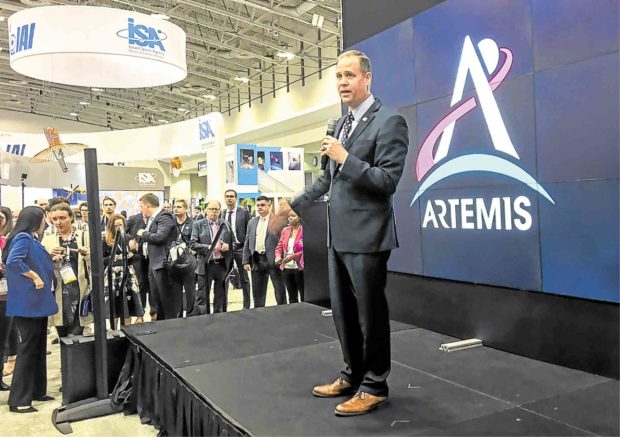US plans return to Moon with partner nations

MOON TRIP Jim Bridenstine, Nasa administrator, speaks from the Artemis stage on Thrsday during the 70th International Astronautical Congress in Washington. Under the Artemis program, the United States plans to set up a long-term colony on the Moon and test technologies for a crewed mission to Mars. —AFP
WASHINGTON—Several countries want their astronauts to hitch a ride with the United States on its next set of lunar missions, but the second nation to have Moon boots on the ground will depend on how much they contribute, Nasa’s chief said on Thursday.
The United States plans to return to the Moon under the Artemis program in order to set up a long-term colony and test technologies for a crewed mission to Mars; it is inviting international partners to take part.
“You can imagine there are going to be a lot of countries to step up to the plate at a level that would say, ‘OK, that warrants having an astronaut on the surface of the Moon,” Jim Bridenstine said, speaking at the 70th International Astronautical Congress in Washington.
The European Space Agency (ESA) and Japan’s space agency have publicly announced they’d like their astronauts to participate in Artemis.
2024 lunar mission
Article continues after this advertisementIt foresees the next set of astronauts on the Moon by 2024 with further missions to follow.
Article continues after this advertisement“The goal is to have many different nations living and working on the Moon at the same time,” Bridenstine said.
Fifteen countries (the United States, Russia, Canada, Japan and several European states) collaborate on the International Space Station and astronauts of 19 nationalities have stayed there.
Barter, in-kind contributions
In the case of the ESA, the partnership is based on barter and in-kind contributions.
Bridenstine said he was not sure if non-Americans would join from the second landing onward, and that it would depend on what they learned from the first.
“But certainly there’s plenty of opportunities when this is sustainable,” he said.
Gateway space station
He reaffirmed that the minilunar space station that the Americans intend to build, called Gateway, will have a lifetime of at least 15 years, and an “open architecture,” meaning the standards for docking ports, life support and communications will be open source.
“Small countries, large countries, private companies, they can build their own landers, and they can send people to the Moon,” Bridenstine said. —AFP